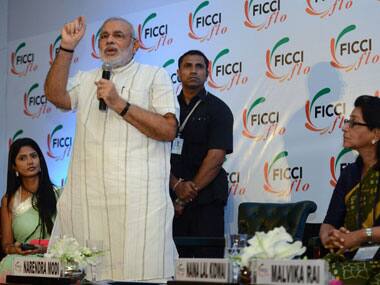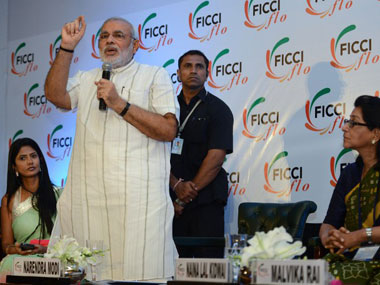by MK Venu “Irrational exuberance” was a term used by the Federal Reserve Chairman Alan Greenspan more than a decade ago to capture purely sentiment driven uptrend in the markets, which eventually evaporated. These sentiments were driven more by psychology than any objective conditions on the ground. [caption id=“attachment_1438671” align=“alignleft” width=“380”]
 BJP’s PM candidate Narendra Modi.[/caption] The Indian stock markets have gained 10% since its lows in February and there is a buoyancy in the market which is being attributed largely to the prospect of Narendra Modi-led BJP coming to power and translating into reality a lot of hype about reviving growth overnight. Such hype is not good for the markets. Investors who are overly relying on just regime change as the main source of growth revival could get a shock within six months after the new government is in place. Even some leading equity research heads working for Foreign Institutional Investment firms have succumbed to the belief that a BJP-led government under Narendra Modi will rescue the bulk of the Indian stocks languishing at less than 40% of their peak values. This belief is based on a simplistic calculation that Modi, assuming he became Prime Minister, will overnight remove various institutional rigidities which have prevented decision making at the Centre on critical infrastructure projects in India. My belief is the policy paralysis of the past 3 years was caused by an inept executive, well meaning but growth-slowing judiciary,and a cautious bureaucracy. Even if you change the government the other institutions remain broadly engulfed in the same framework of RTI, Lokpal etc. So it might be risky to build too much hype about transformation in decision-making overnight. There are some analysts who are advocating a cautious approach. Head of Research at ICICI Direct, Mr.Pankaj Pandey, told a business TV channel, “If you look at from Feb lows, we have gained about 10 per cent and largely driven by the improvement in sentiments… So sentiments probably can take the markets to even higher levels till ahead of elections between 6500 to 7000 kind of a range. But we would not expect markets to rally too much beyond that because the growth is now driven only by few select sectors like IT and pharma." The point Mr. Pandey makes is growth is not broad-based at all and that the positive sentiment being generated by the possibility of a Modi-led BJP regime cannot sustain the stock market rally after the elections. Pandey particularly emphasises that the stock markets may rise some more – may be another 10 %– in the run up to the general election but would probably start to decline after the election when reality dawns that a mere regime change does not do the trick. So I anticipate that the hype of a regime change will begin to wear away after it becomes clear that the BJP-led government( assumption based on pre-poll surveys) is no different from any other coalition leader and will have to deal with many demanding allies who are ready to extract their pound of flesh. This writer recently spoke to the heads of CII and FICCI, the two main industry associations, and both were clear that real growth will pick up only when the current equation between key institutions such as the judiciary, bureaucracy, executive and legislature gets repaired. The bureaucracy, for instance, will not start clearing projects automatically because the civil society today is far more empowered through instruments such as the Right to Information Act. The RTI Act and the setting up of Lok Pal have unleashed new institutional reforms which the system will take time to adjust to. This is being underestimated by everyone who thinks a new government will set right everything overnight. The President of FICCI Sidharth Birla echoed this sentiment when he told this writer,” Whichever government is in place will have to deal with multiple legal and bureaucratic disputes over allocation of natural resources such as coal, iron ore etc. Unless all stakeholders—political class, judiciary, bureaucracy – sit together and resolve outstanding issues it is unlikely that sustained growth will come back." If the current institutional logjam is not resolved quickly enough, the stock market, already bloated on high expectations from the new regime—will surely get a shock some six months after the new government is installed. It is this possibility which is most daunting at present. Of course, the one advantage any new government will have is that some macro fundamentals are clearly on the mend. The ever bulging current account deficit, a grave problem until six months ago, has crashed to less than 2% of GDP in 2013-14. India was running an average Current Account deficit of over 4% in the previous three fiscals. This was causing huge worry to policy makers over whether India could sustain its import and export-led growth. Inflation, the key cause of decline in the UPA’s popularity, is also tapering off substantially. The wholesale price Index and the Consumer price index are showing inflation rates at 5% and 8% respectively. This is the best performance in recent years. These are some positive that any new government will enjoy. But to revive private investments, the government will have to do a whole lot of other things. M.K.Venu is Executive Editor with Amar Ujala Group.
BJP’s PM candidate Narendra Modi.[/caption] The Indian stock markets have gained 10% since its lows in February and there is a buoyancy in the market which is being attributed largely to the prospect of Narendra Modi-led BJP coming to power and translating into reality a lot of hype about reviving growth overnight. Such hype is not good for the markets. Investors who are overly relying on just regime change as the main source of growth revival could get a shock within six months after the new government is in place. Even some leading equity research heads working for Foreign Institutional Investment firms have succumbed to the belief that a BJP-led government under Narendra Modi will rescue the bulk of the Indian stocks languishing at less than 40% of their peak values. This belief is based on a simplistic calculation that Modi, assuming he became Prime Minister, will overnight remove various institutional rigidities which have prevented decision making at the Centre on critical infrastructure projects in India. My belief is the policy paralysis of the past 3 years was caused by an inept executive, well meaning but growth-slowing judiciary,and a cautious bureaucracy. Even if you change the government the other institutions remain broadly engulfed in the same framework of RTI, Lokpal etc. So it might be risky to build too much hype about transformation in decision-making overnight. There are some analysts who are advocating a cautious approach. Head of Research at ICICI Direct, Mr.Pankaj Pandey, told a business TV channel, “If you look at from Feb lows, we have gained about 10 per cent and largely driven by the improvement in sentiments… So sentiments probably can take the markets to even higher levels till ahead of elections between 6500 to 7000 kind of a range. But we would not expect markets to rally too much beyond that because the growth is now driven only by few select sectors like IT and pharma." The point Mr. Pandey makes is growth is not broad-based at all and that the positive sentiment being generated by the possibility of a Modi-led BJP regime cannot sustain the stock market rally after the elections. Pandey particularly emphasises that the stock markets may rise some more – may be another 10 %– in the run up to the general election but would probably start to decline after the election when reality dawns that a mere regime change does not do the trick. So I anticipate that the hype of a regime change will begin to wear away after it becomes clear that the BJP-led government( assumption based on pre-poll surveys) is no different from any other coalition leader and will have to deal with many demanding allies who are ready to extract their pound of flesh. This writer recently spoke to the heads of CII and FICCI, the two main industry associations, and both were clear that real growth will pick up only when the current equation between key institutions such as the judiciary, bureaucracy, executive and legislature gets repaired. The bureaucracy, for instance, will not start clearing projects automatically because the civil society today is far more empowered through instruments such as the Right to Information Act. The RTI Act and the setting up of Lok Pal have unleashed new institutional reforms which the system will take time to adjust to. This is being underestimated by everyone who thinks a new government will set right everything overnight. The President of FICCI Sidharth Birla echoed this sentiment when he told this writer,” Whichever government is in place will have to deal with multiple legal and bureaucratic disputes over allocation of natural resources such as coal, iron ore etc. Unless all stakeholders—political class, judiciary, bureaucracy – sit together and resolve outstanding issues it is unlikely that sustained growth will come back." If the current institutional logjam is not resolved quickly enough, the stock market, already bloated on high expectations from the new regime—will surely get a shock some six months after the new government is installed. It is this possibility which is most daunting at present. Of course, the one advantage any new government will have is that some macro fundamentals are clearly on the mend. The ever bulging current account deficit, a grave problem until six months ago, has crashed to less than 2% of GDP in 2013-14. India was running an average Current Account deficit of over 4% in the previous three fiscals. This was causing huge worry to policy makers over whether India could sustain its import and export-led growth. Inflation, the key cause of decline in the UPA’s popularity, is also tapering off substantially. The wholesale price Index and the Consumer price index are showing inflation rates at 5% and 8% respectively. This is the best performance in recent years. These are some positive that any new government will enjoy. But to revive private investments, the government will have to do a whole lot of other things. M.K.Venu is Executive Editor with Amar Ujala Group.
Markets surge over Modi hype but post elections, rude shock awaits
FP Archives
• March 18, 2014, 13:16:53 IST
The prospect of a Modi-led government has made the market buoyant. But Investors overly relying on just regime change as the main source of growth revival could get a shock within six months of the new government.
Advertisement
)